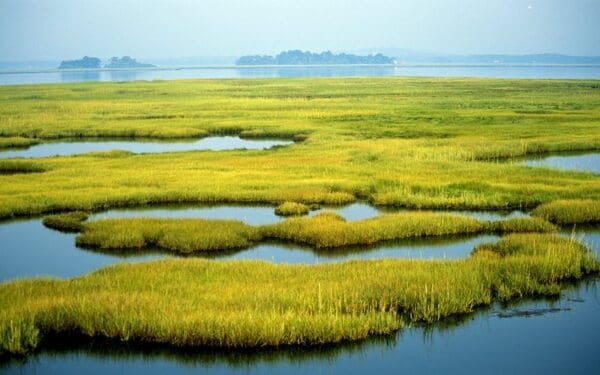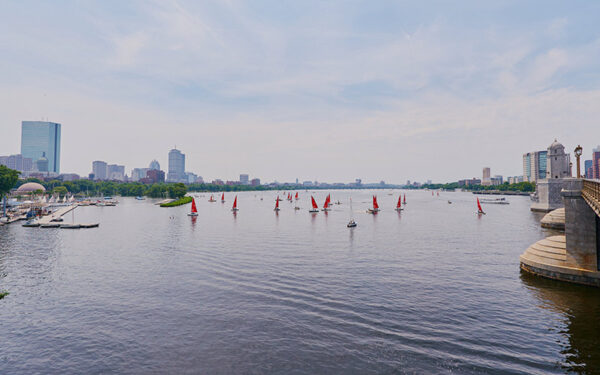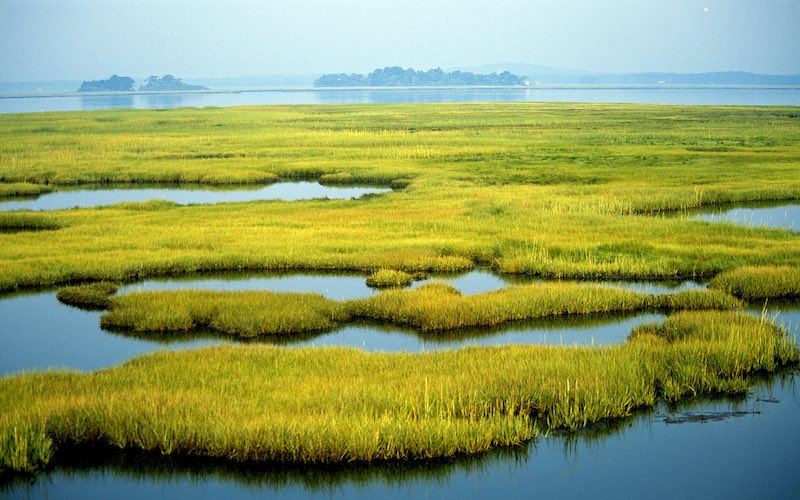
A view of wetlands in Newburyport, Massachusetts. Photo: U.S. Fish and Wildlife Service via Flikr
This blog was originally published in May 2024 and updated September 2025.
You may have heard a lot of talk lately about “wetlands.” They’re often touted as one of our best tools in making both rural hamlets and urban neighborhoods more resilient to the effects of climate change.
But let’s be honest. Do we really know what wetlands are? And for those who know, aren’t they the places we’ve spent a good part of our lives trying to avoid? Think swamps and bogs, marshes, and fens. What’s so important about preserving muddy fields known for clouds of voracious mosquitoes?
Okay, while you might not choose a wetland as a site for an afternoon picnic, it’s worth understanding wetlands’ critical role in our ecosystem. Once you know, you’ll never use the terms “morass,” “mire,” or “quagmire” in quite the same way again.
What Are Wetlands and Where Are They?
A wetland is an area where water covers soil (or, if it doesn’t cover it completely, it stands near the surface of the soil) for nearly the entire year. Examples might include fields of reedy grasses sprouting in a soggy bog or red maples rising majestically from wet, mucky earth.
Wetlands tend to fall into two general types: those near an ocean, called coastal/tidal wetlands, and those inland or non-tidal wetlands. Coastal wetlands are often saltwater marshes located along inlets near the sea. They also include estuaries, mangroves, lagoons, and coral reefs. In New England, coastal wetlands play a critical role in protecting shorelines from erosion, providing habitat for a variety of fish and wildlife, and maintaining water quality. These areas are particularly important as they serve as nurseries for many marine species.
Inland wetlands are mainly freshwater ecosystems that get water from streams. They include different kinds of wetlands like marshes, bogs, swamps, and fens. For example, the Connecticut River Valley sports marshes that provide key habitats for migrating birds, among a rich range of other animals and plants. Fens are unique wetlands where peat develops and distinct habitats form, making them important for biodiversity. Many New England inland wetlands are also floodplains, which help absorb and manage floods.
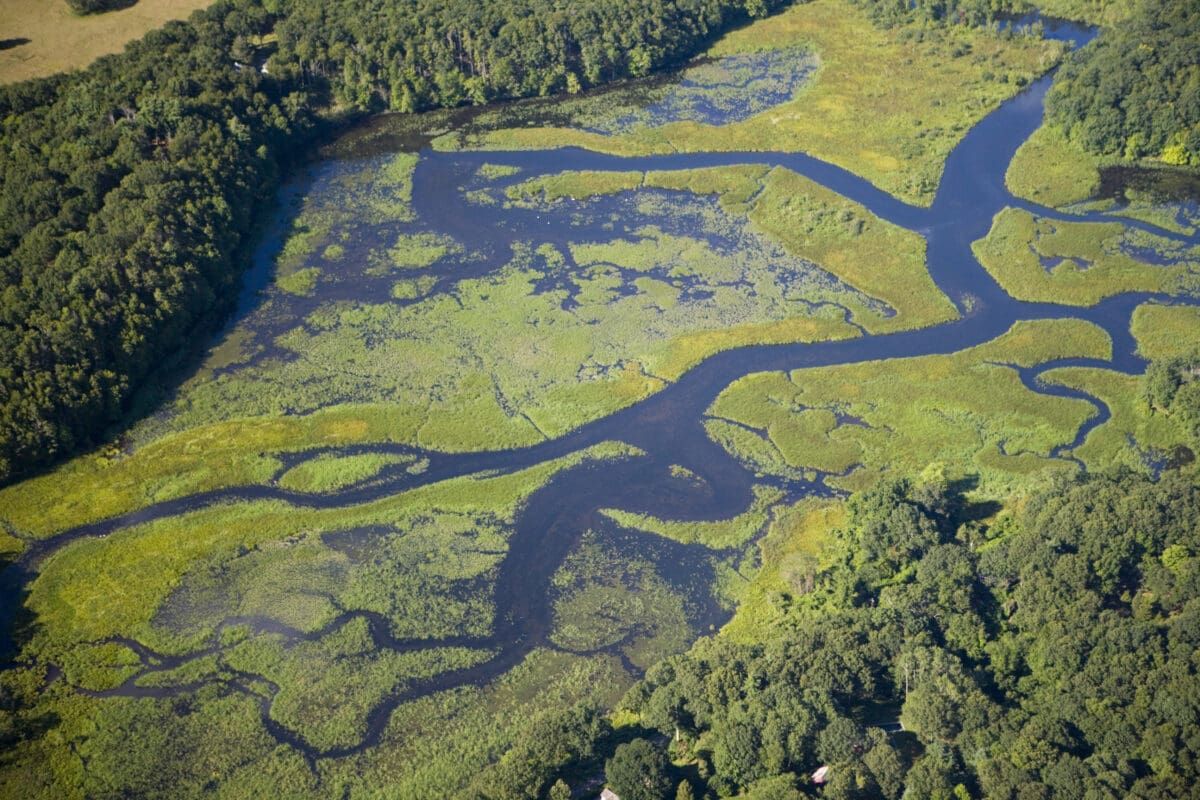
Around New England, examples of wetlands include the Great Marsh, the 25,500 acres of continuous salt marsh that runs from Cape Ann in northeastern Massachusetts to the southeastern coast of New Hampshire; the LaPlatte River Marsh in Vermont; and 20 percent of Maine’s Acadia Park. Cape Cod’s estuaries are wetlands where saltwater from the ocean mixes with freshwater ponds. Connecticut and Rhode Island have wetlands, too.
Some may be surprised to learn that wetlands are found not only in rural areas but also in urban ones. One urban wetland is the Back Bay Fens in Boston. It was once a saltwater marsh that landscape architect Frederick Law Olmsted turned into a meandering park with a freshwater stream by damming the Charles River. The wide variety of wetland types show how diverse and unique wetlands can be.
The Importance of Wetlands: Biodiversity, Resilience, Climate Change, Ecosystems
Now, there are some specific reasons why wetlands are getting so much buzz these days. They are our most important tool against climate change, but we’re losing them fast. Not only are they a source of rich biodiversity, home to an incredible variety of plants and animals, but they are also giant absorbent sponges that soak up a whole host of human-made ills.
After one of those violent downpours we’ve been experiencing more often because of climate change, wetlands, like a welcoming aunt, can gracefully accept any water overflowing riverbanks and coastlines. Floodplains – that flat area surrounding a river or stream – make an easy “holding tank” for a deluge of water and can help divert water away from settled areas. Plus, in coastal areas, the vegetation growing in wetlands absorbs the energy of coastal waves, protecting mainland areas from erosion and damage from waves.
Another critical function becoming more important with each passing year is their ability to store the carbon in our air. According to the U.S. Global Change Research Program, wetlands in the continental United States store 13.5 billion metric tons of carbon. When we lose wetlands, we lose a “carbon sink,” and the carbon that would otherwise get buried is released into the atmosphere. That means climate change worsens, the planet heats up faster, we witness more extreme storms, and we lose more species and wetlands in a doom loop.
Wetlands also maintain water quality by filtering pollutants from the water that flows through them. This is essential for supporting habitats that need clean water to thrive. These habitats support a vibrant variety of animals, including many threatened and endangered species. In addition to their ecological benefits, wetlands also provide opportunities to fish, birdwatch, and hike that can’t be found anywhere else. Wetlands cover millions of acres in the United States, and protecting and restoring them is vital for the health of the natural world.
Wetlands Are Facing Threats
And here we arrive at the problem. Wetlands are home to 40% of the world’s plant and animal species and 30% of the known fish species. They provide a safe place for water to flow after storms. They suck up all the carbon out of our dirty air. And yet, despite these invaluable services, they’re disappearing.
Climate change is one of the primary threats to wetlands. Spiking temperatures and extreme weather can alter water levels, disrupting the web of life. Coastal wetlands, such as salt marshes, are particularly vulnerable to sea-level rise, which can submerge these areas and destroy their delicate habitats.
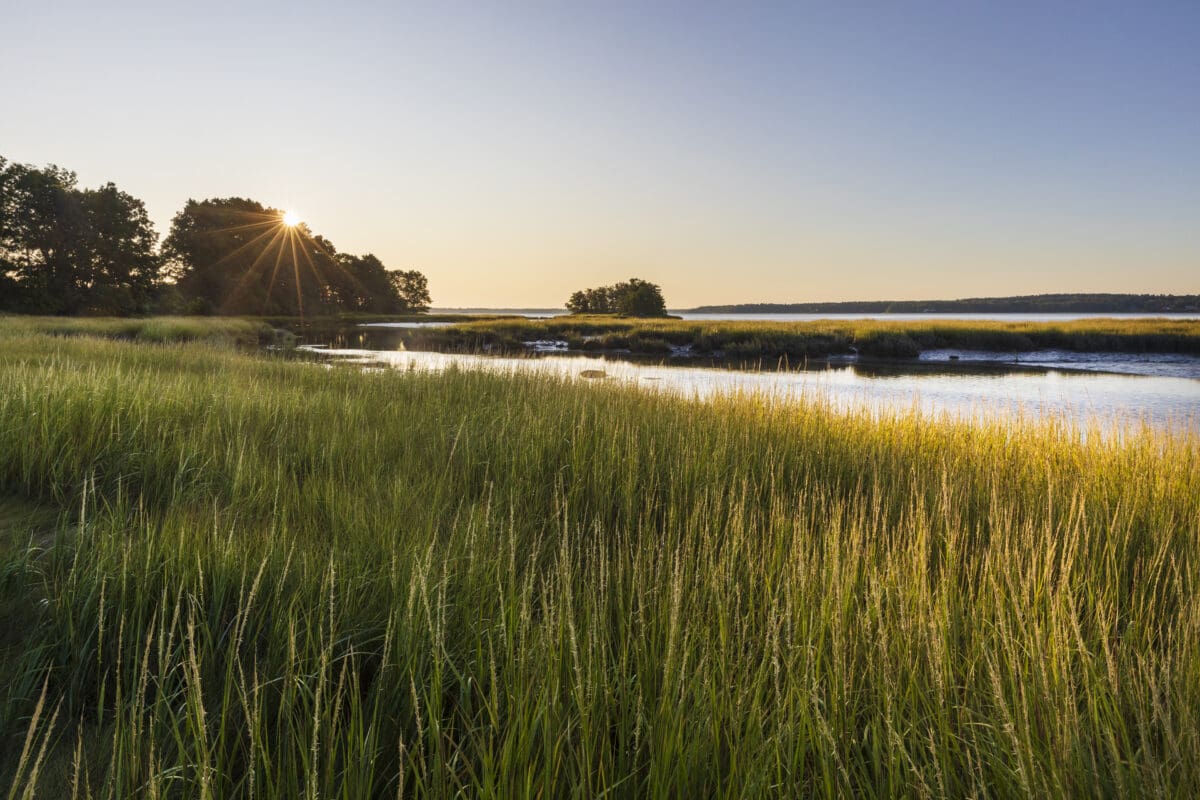
Unfortunately, climate change isn’t the only threat facing wetlands. Developers sometimes drain and fill in wetlands. Polluted runoff containing fertilizers, pesticides, and other toxic chemicals can damage any wetlands that it touches.
Since 2009, the rate of wetland loss has accelerated by 50%. About 80,000 acres of wetland are lost each year, and that’s just coastal wetlands. Between 2009 and 2019, the disappearance of all wetlands resulted in a loss equal to the land area of Rhode Island.
A recent shift in federal regulations is only worsening this issue. The Clean Water Act protects the “waters of the United States,” a legal definition that used to include wetlands. Unfortunately, the Supreme Court has ruled that most wetlands no longer fall under this classification, so these key areas no longer receive proper federal protection.
Protecting Our Wetlands
Overall, wetlands are some of the most productive ecosystems on earth and play a critical role in supporting life. It’s essential to recognize their value and take action to preserve and restore these vital areas before they are lost forever.
As we lose wetlands, we lose more plants and animals. Between 1970 and 2014, wetland populations of fish, birds, mammals, amphibians, and reptiles fell by 60%. And as we remove each piece of the environmental puzzle, the whole picture unravels. The entire system breaks down in a chain reaction. The final big loser will be you and me.
For all these good reasons, you’ve been hearing a lot about wetlands. This is also why CLF has been fighting hard to protect the wetlands that still exist.
It’s never been more evident that we need these natural areas and must protect them. Otherwise, we’ll find ourselves in a different sort of quagmire.
This is one in an occasional series revealing the truth on environmental issues.

